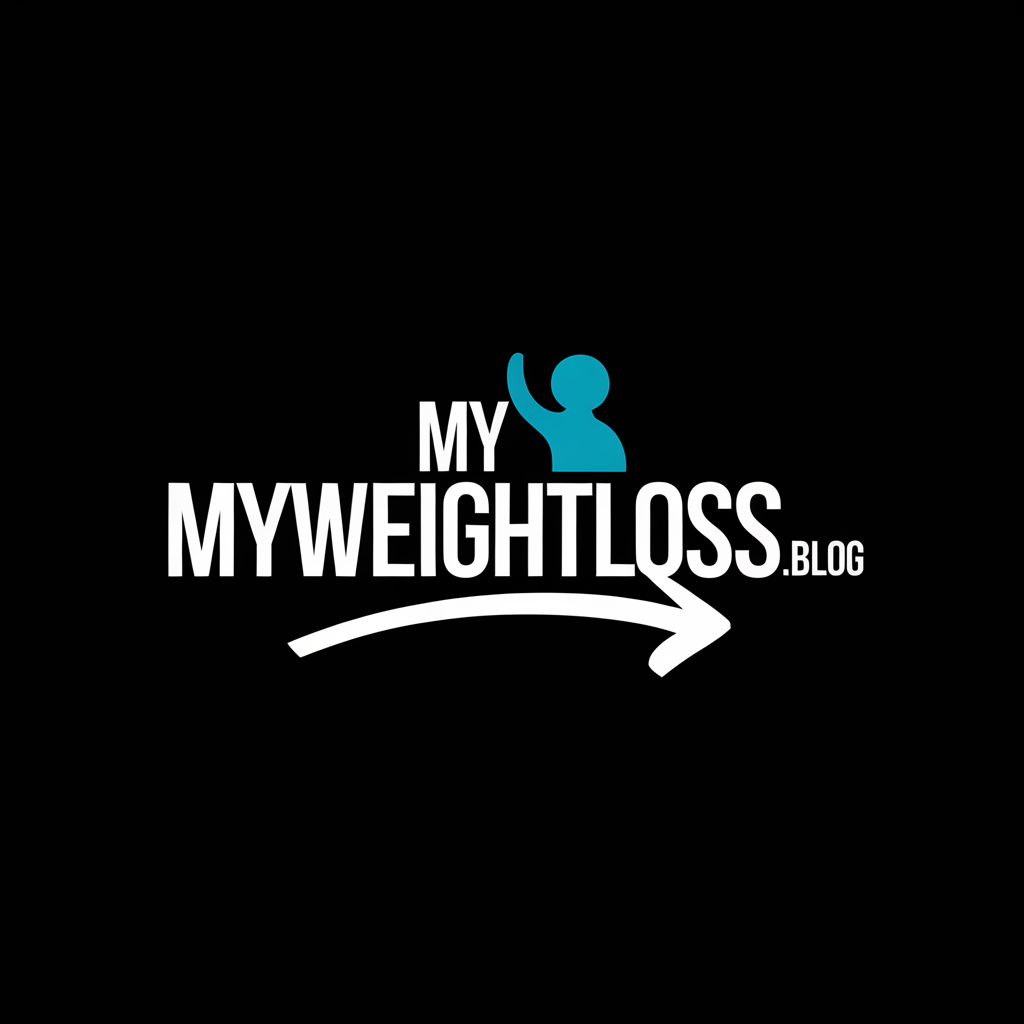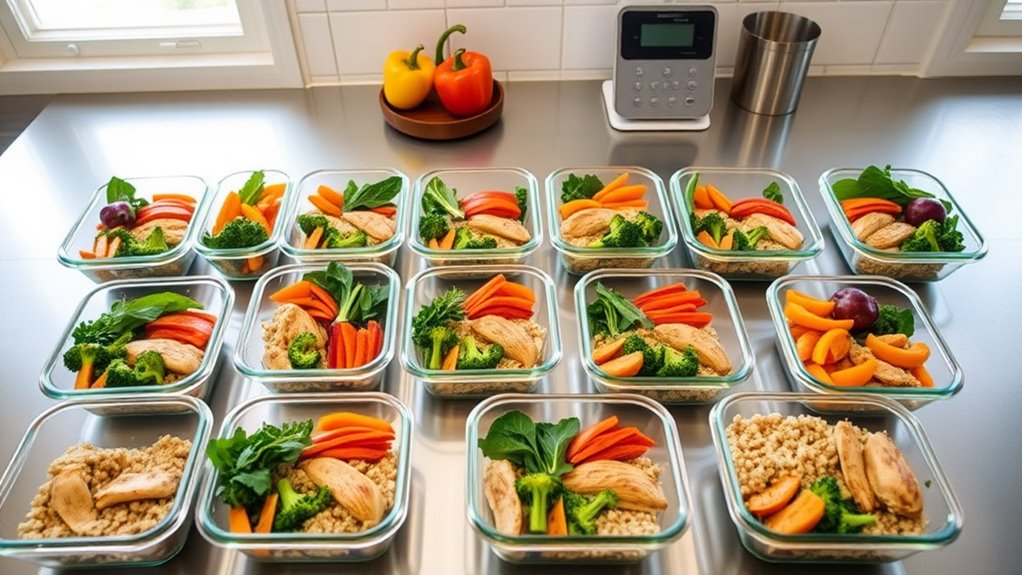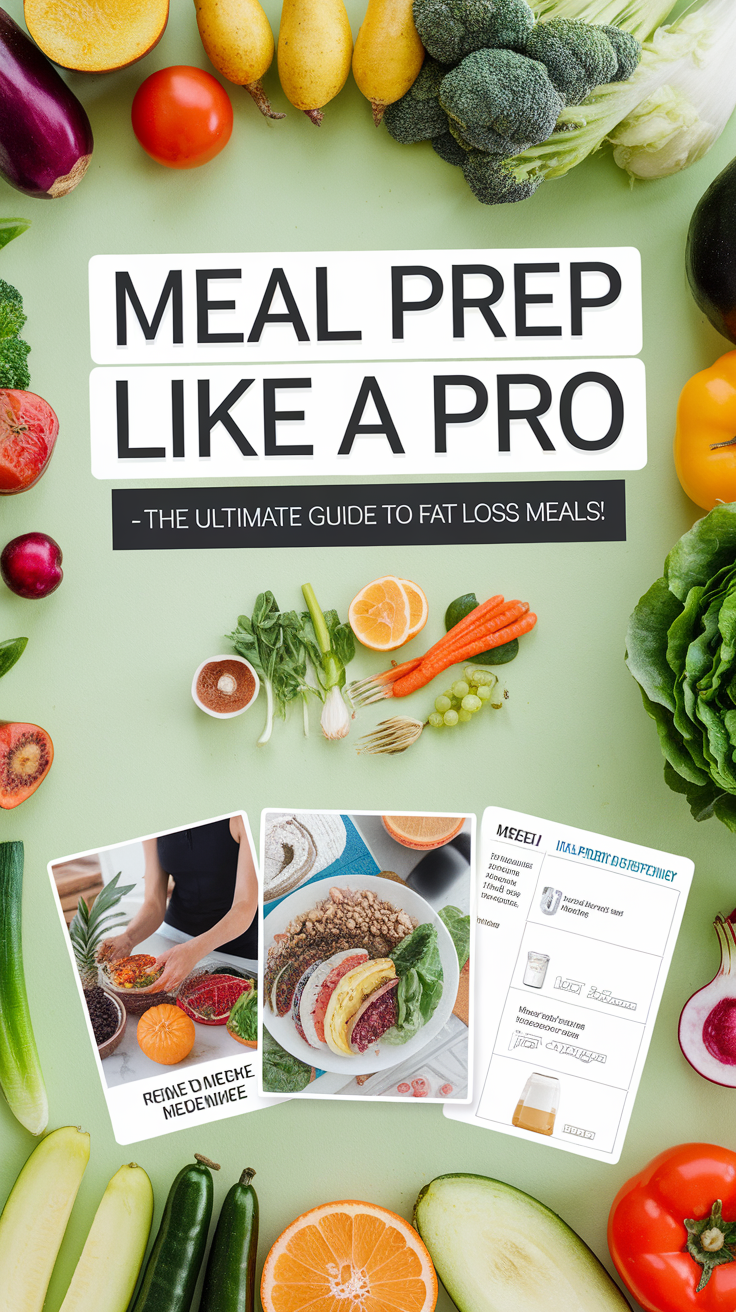Meal Prep Like a PRO – The Ultimate Guide to Fat Loss Meals!
You’re about to discover how meal prepping can transform your fat loss journey from frustrating to manageable. When you take control of your meals in advance, you’ll eliminate those impulsive food decisions that derail your progress. Whether you’re a busy professional or a time-strapped parent, strategic meal prep isn’t just about containers and cooking—it’s your blueprint for sustainable results. Let’s unlock the proven strategies that successful meal preppers use to reach their goals.
Why Meal Prep Is Your Secret Weapon for Fat Loss
When you have complete control over your food choices and portions, achieving your fat loss goals becomes significantly easier.
Meal prep hands you that control by eliminating impulsive eating decisions and removing the “what’s for dinner?” stress that often leads to unhealthy choices.
You’ll join countless others who’ve discovered that preparing meals in advance keeps you accountable and on track. By planning your portions and ingredients, you’re getting ahead of cravings and preventing those last-minute takeout orders.
You’re also saving money and time throughout the week, making it easier to stick to your nutrition plan even during busy days.
Best of all, meal prep creates a sustainable routine that supports long-term success in your fat loss journey, helping you build habits that last.
Essential Kitchen Tools and Storage Containers
Before diving into meal prep, you’ll need to stock your kitchen with the right tools and containers. Start with high-quality meal prep containers in various sizes – glass or BPA-free plastic options with secure lids will keep your food fresh and prevent leaks.
You’ll also want a reliable food scale, sharp knives, and a set of measuring cups and spoons for portion control.
Essential tools include a large cutting board, mixing bowls, and sheet pans for batch cooking. A good blender helps with smoothies and sauces, while a rice cooker can handle grains while you prep other items.
Don’t forget cooking utensils like tongs and spatulas. For organization, invest in drawer dividers and label makers to keep your prep station efficient and your containers properly dated.
Smart Grocery Shopping Strategies for Budget-Friendly Prep
Smart grocery shopping starts with strategic planning to maximize your budget and minimize waste.
You’ll want to plan your meals around seasonal produce and store sales while buying in bulk when it makes sense. Creating a detailed shopping list helps you stay focused and avoid impulse purchases that can derail both your budget and nutrition goals.
-
Shop the perimeter of the store first, where you’ll find fresh produce, lean proteins, and dairy.
-
Check weekly circulars and plan your meals around what’s on sale.
-
Buy frozen fruits and vegetables when fresh options are expensive.
-
Stock up on shelf-stable items like beans, rice, and spices during sales.
-
Visit local farmers’ markets near closing time for potential discounts.
Remember to compare unit prices rather than package prices, and don’t shop when you’re hungry to avoid unnecessary purchases.
Mastering Portion Control for Maximum Results
Understanding portion control is the cornerstone of successful fat loss, regardless of which foods you’re eating. You’ll get better results when you measure and track your portions consistently, rather than eyeballing or guessing.
Start by investing in a food scale and measuring cups – they’re your new best friends. When prepping meals, divide your plate into sections: half for vegetables, quarter for lean protein, and quarter for complex carbs.
You’ll want to keep protein portions about the size of your palm, carbs the size of your cupped hand, and fats the size of your thumb.
Pre-portioning your meals into containers helps you stay on track and avoid overeating. Remember, you’re not restricting – you’re simply being mindful of serving sizes to reach your goals efficiently.
Time-Saving Cooking Methods and Batch Cooking Tips
Now that you’ve mastered portion sizes, let’s make your meal prep more efficient. Your fellow meal preppers know that smart cooking methods save precious time while maintaining nutritional value.
Get ready to transform your kitchen into a fat-loss meal factory with these game-changing techniques:
-
Sheet pan meals – roast protein and veggies together for hands-free cooking
-
Instant Pot or pressure cooker – perfect for tender meats and beans in minutes
-
Air fryer batches – crispy results with minimal oil and cleanup
-
One-pot wonders – combine ingredients for complete meals with less washing
-
Slow cooker bulk cooking – prep ingredients before work, dinner’s ready later
Batch cooking doesn’t just save time – it keeps you consistent with your goals.
Cook proteins and complex carbs in bulk, then mix and match throughout the week for variety.
Best Protein, Carb, and Fat Combinations for Fat Loss
You’ll need to master the right balance of macronutrients to optimize your fat loss journey, focusing on lean proteins, complex carbohydrates, and healthy fats.
Your macro ratios should shift throughout the day, with protein and fats taking priority in the morning while strategically timing most carbohydrates around workouts and active periods.
Macros for Fat Loss
When it comes to fat loss, your macronutrient ratios play a crucial role in achieving sustainable results.
You’ll want to structure your daily intake around a proven macro split that supports both fat loss and muscle preservation.
For optimal fat loss results, follow these macro guidelines:
- Protein: 30-35% of total calories (1g per pound of body weight)
- Carbohydrates: 35-40% of total calories (focus on complex carbs)
- Fats: 25-30% of total calories (emphasize healthy sources)
- Fiber: 25-35g daily for satiety and digestive health
- Water: 1 gallon daily to support metabolism
Remember to adjust these ratios based on your activity level, body composition, and personal response to different macro splits.
Track your intake using a food diary or app to ensure you’re hitting your targets consistently.
Timing Your Nutrient Balance
Understanding when to eat specific macro combinations can maximize your fat loss results beyond just hitting daily targets.
You’ll want to structure your meals around your workouts and daily activity patterns for optimal results.
Start your day with protein and healthy fats to stabilize blood sugar and provide sustained energy.
Before workouts, combine moderate protein with fast-digesting carbs to fuel performance.
Post-workout, increase your carbs and protein while keeping fats low to enhance recovery and muscle preservation.
For your evening meals, focus on protein and fibrous vegetables while reducing carbs.
This strategy helps maintain stable insulin levels overnight and supports fat burning during sleep.
If you’re hungry between meals, choose protein-rich snacks with a small amount of healthy fats to stay satisfied without disrupting fat loss.
Clean Combo Meal Examples
Creating balanced meal combinations is essential for sustained fat loss while maintaining muscle and energy. You’ll want to focus on meals that combine lean proteins, complex carbs, and healthy fats to keep you satisfied and energized throughout your day.
Here are some winning combinations that’ll help you reach your fat loss goals:
- Grilled chicken breast with quinoa and roasted brussels sprouts drizzled in olive oil
- Wild-caught salmon with sweet potato wedges and steamed broccoli
- Greek yogurt parfait layered with berries, chia seeds, and a sprinkle of granola
- Turkey and avocado roll-ups with bell peppers and hummus
- Egg white omelet stuffed with spinach, mushrooms, and a side of ezekiel toast
Mix and match these combinations to keep your meals interesting while staying on track with your fat loss journey.
Make-Ahead Recipes and Weekly Meal Plans
You’ll discover how simple meal prep strategies can accelerate your fat loss goals through time-saving batch cooking, proper storage techniques, and precise portion control.
Following a five-day meal template lets you plan, shop, and prepare your weekly meals efficiently while maintaining variety and nutritional balance.
Time-Saving Batch Cooking
Smart batch cooking can slash your weekly meal prep time in half while keeping you on track with your fat loss goals.
Join thousands of successful meal preppers who’ve discovered the power of cooking multiple portions at once.
Here’s what you’ll want to batch cook on your prep day:
- Lean proteins like grilled chicken breasts, turkey meatballs, or baked fish fillets
- Complex carbs including brown rice, quinoa, or sweet potatoes
- Roasted vegetables seasoned with your favorite herbs and spices
- Hard-boiled eggs for quick protein-packed snacks
- Homemade sauces and dressings to keep meals exciting
Store your batch-cooked items in portion-sized containers, and you’ll have grab-and-go meals ready for the week.
You’ll feel confident knowing you’re prepared with healthy options that support your fat loss journey.
Storage and Portion Control
Once you’ve mastered batch cooking, proper storage and portion control become your next keys to success. Store your prepped meals in high-quality containers that’ll keep your food fresh and organized throughout the week.
| Container Type | Best For |
|---|---|
| Glass containers | Hot meals, reheating |
| Mason jars | Salads, overnight oats |
| Portion containers | Precise macro tracking |
| Freezer bags | Long-term storage |
You’ll want to measure your portions accurately using a food scale and measuring cups. Consider investing in color-coded containers that correspond to specific portion sizes – they’re perfect for maintaining consistent serving sizes. Remember to label everything with dates and contents. When you’re organized with storage and portions, you’ll find it easier to stick to your fat loss goals while saving time and reducing waste.
Five-Day Meal Templates
A well-structured five-day meal template serves as your roadmap to successful fat loss. By planning your meals in advance, you’ll avoid impulsive food choices and stay committed to your goals.
Your template should include balanced portions of lean proteins, complex carbs, and healthy fats while maintaining your target calorie range.
Create your winning template with these fat-burning meal combinations:
- Monday: Grilled chicken breast with quinoa and roasted vegetables
- Tuesday: Baked salmon with sweet potato and steamed broccoli
- Wednesday: Turkey and black bean burrito bowl with brown rice
- Thursday: Lean beef stir-fry with cauliflower rice and snap peas
- Friday: Greek yogurt protein bowl with berries and chia seeds
Prep these meals in bulk on Sunday, and you’ll have a week’s worth of perfectly portioned, fat-burning meals ready to go.
Frequently Asked Questions
How Long Can I Safely Keep Meal-Prepped Food in the Freezer?
You can keep most meal-prepped foods in your freezer for 3-6 months when stored properly. Just make sure you’re using airtight containers and labeling everything with dates.
Can I Meal Prep if I Have Food Allergies or Dietary Restrictions?
You can definitely meal prep with food allergies or restrictions! Simply customize your recipes, carefully read labels, and prep separately to avoid cross-contamination. Many alternatives exist for common allergens.
What Are the Signs That Meal-Prepped Food Has Gone Bad?
Look for mold, off-putting smells, slimy textures, or unusual color changes in your prepped meals. If you’re not sure, it’s better to toss it than risk getting sick.
Should I Eat the Same Meals Every Day When Meal Prepping?
You don’t have to eat identical meals daily. Mix up your proteins, veggies, and grains while keeping portions consistent. You’ll stay motivated and still meet your nutritional goals.
Can I Meal Prep Smoothies and Fresh Juices in Advance?
You can prep smoothie ingredients in freezer bags and blend them when needed. For juices, it’s best to drink them fresh since they lose nutrients and taste quickly after preparation.


